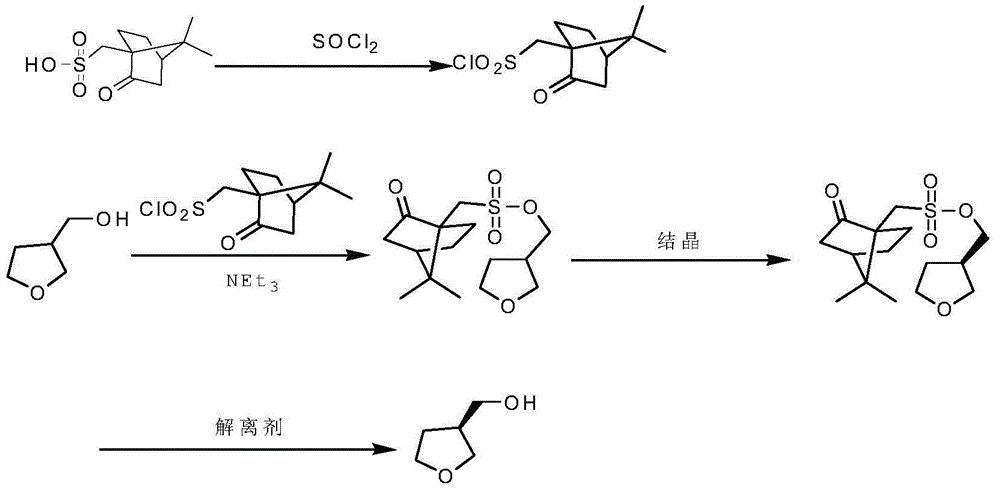A method for synthesizing s-(+)-tetrahydrofuran-3-methanol
A technology for tetrahydrofuran and methanol, which is applied in the field of synthesizing S--tetrahydrofuran-3-methanol, can solve the problems of complex synthesis steps, low yield, high catalyst cost, etc., and achieve the effect of simple synthesis route, cheap raw materials and easy availability of raw materials
- Summary
- Abstract
- Description
- Claims
- Application Information
AI Technical Summary
Problems solved by technology
Method used
Image
Examples
Embodiment 1
[0018] In a 50mL round-bottomed flask, add 20mL of dichloromethane as a solvent, add 2.78g (12mmol) of D(+)-10-camphorsulfonic acid and 2.02g (17mmol) of thionyl chloride, mix well, and reflux at 50°C for 2h. This gives D(+)-10-camphorsulfonyl chloride. Add 1.02g (10mmol) (±)-tetrahydrofuran-3-methanol and 2.02g (20mmol) triethylamine to 20mL dichloromethane as solvent under ice bath and mix evenly, the obtained D(+)-10-camphorsulfonyl chloride Slowly add dropwise (20 minutes) with a dropping funnel, return to 25°C and stir for 6 hours, add 1.4g (17mmol) saturated sodium bicarbonate solution, stir for 10 minutes, extract with 20×3mL dichloromethane, dry over anhydrous sodium sulfate , filtered and evaporated the solvent under reduced pressure. Purify by column chromatography (ethyl acetate to petroleum ether 0-0.5), distill off the solvent under reduced pressure to obtain 2.78 g of tetrahydrofuran-3-methylcamphorsulfonate (yield 88%), and leave it in the air for 48 hours to o...
Embodiment 2
[0021] In a 50mL round-bottomed flask, add 30mL of dichloromethane as a solvent, add 2.32g (10mmol) of D(+)-10-camphorsulfonic acid and 1.67g (14mmol) of thionyl chloride, mix well, and reflux at 50°C for 3h. This gives D(+)-10-camphorsulfonyl chloride. Add 1.02g (10mmol) (±)-tetrahydrofuran-3-methanol and 2.02g (20mmol) triethylamine to 10mL N,N-dimethylformamide as solvent under ice-cooling, and mix well to obtain D(+)- 10-camphorsulfonyl chloride was slowly added dropwise with a dropping funnel (taking 20 minutes), returned to 25°C and stirred for 2 hours, added 1.17g (14mmol) saturated sodium bicarbonate solution, stirred for 10 minutes, extracted with 20×3mL ethyl acetate , dried over anhydrous sodium sulfate, filtered and evaporated under reduced pressure to remove the solvent. Purify by column chromatography (ethyl acetate to petroleum ether 0-0.5), distill off the solvent under reduced pressure to obtain 2.29 g of tetrahydrofuran-3-methylcamphorsulfonate (yield 72.4%)...
Embodiment 3
[0023] In a 100mL round-bottomed flask, add 50mL of dichloromethane as a solvent, add 4.64g (20mmol) of D(+)-10-camphorsulfonic acid and 3.34g (28mmol) of thionyl chloride, mix well, and reflux at 50°C for 2h. This gives D(+)-10-camphorsulfonyl chloride. Add 1.02g (10mmol) (±)-tetrahydrofuran-3-methanol and 2.02g (20mmol) triethylamine to 50mL dichloromethane as solvent under ice-cooling and mix well, and the obtained D(+)-10-camphorsulfonyl chloride Slowly add dropwise with a dropping funnel (taking 20 minutes), return to 25°C and stir for 24 hours, add 2.34g (28mmol) saturated sodium bicarbonate solution, stir for 10 minutes, extract with 20×3mL dichloromethane, anhydrous sodium sulfate Dry, filter and distill off the solvent under reduced pressure. Purify by column chromatography (ethyl acetate to petroleum ether 0-0.5), distill off the solvent under reduced pressure to obtain 2.81 g of tetrahydrofuran-3-methyl camphorsulfonate (yield 89%), and leave it in the air for 36 h...
PUM
 Login to View More
Login to View More Abstract
Description
Claims
Application Information
 Login to View More
Login to View More - R&D
- Intellectual Property
- Life Sciences
- Materials
- Tech Scout
- Unparalleled Data Quality
- Higher Quality Content
- 60% Fewer Hallucinations
Browse by: Latest US Patents, China's latest patents, Technical Efficacy Thesaurus, Application Domain, Technology Topic, Popular Technical Reports.
© 2025 PatSnap. All rights reserved.Legal|Privacy policy|Modern Slavery Act Transparency Statement|Sitemap|About US| Contact US: help@patsnap.com

